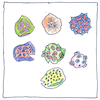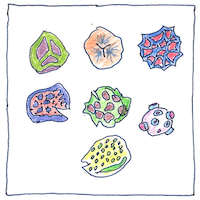Nehemiah Grew,
Robert Kidston
palynology

|
Palynology
The study of strewn particles the dust of plants the dust of centuries. Nehemiah Grew discovered that the pollen of a plant, its size and shape, is characteristic of the plant and necessary for its reproduction. Robert Kidston studied fossil spores related them to living species and used them to correlate coal seams.
Fossil palynology
Archean sedimentary rock Devonian and Carboniferous coal seams Cenozoic oceanic sediments Neoproterozoic deposits dinocysts, acritarchs spores, pollen, fungi chitinozoans, foraminifera scolecodonts, arthropod body parts
Politics
It would be unkind to compare certain politicians with fossils. Unlike fossils, they live, they breathe, and they threaten others. Putting them under a microscope, we discover more about ourselves.



Many scientists have contributed to palynology. The term palynology means “the study of dust,” and was coined in 1944.
See also in The book of science:
Readings in wikipedia:
Other readings: